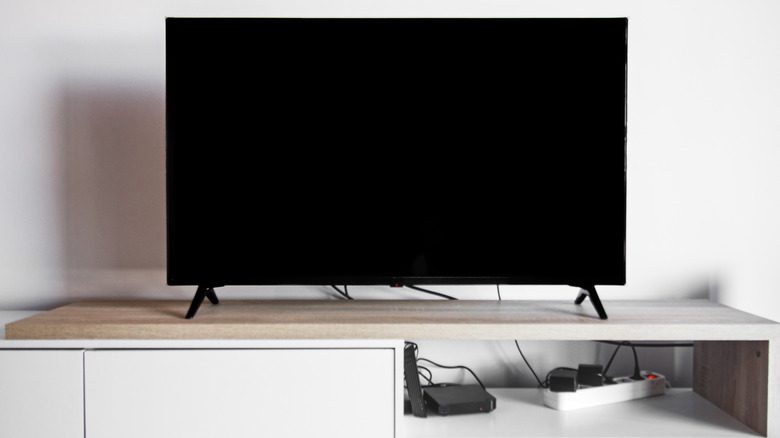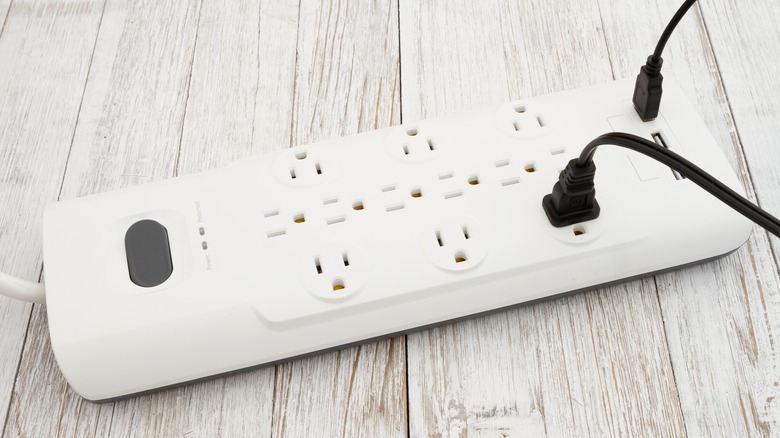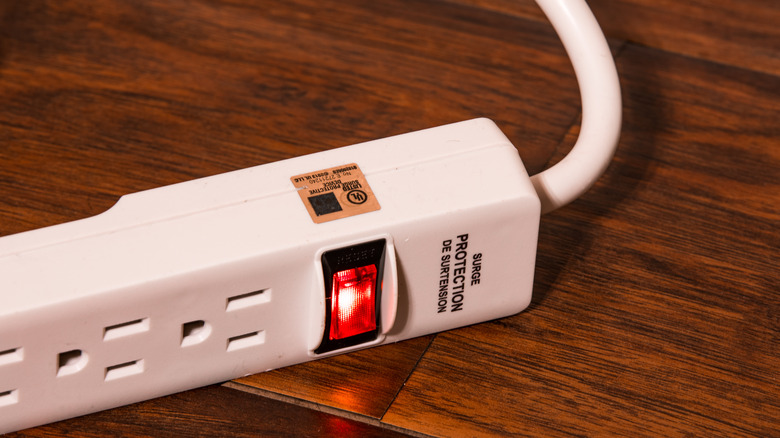Should You Be Plugging Your TV Into A Surge Protector?
There's a good chance your TV is at the center of your home entertainment setup, so you can watch the big game, use must-have streaming services to watch your favorite shows and movies, or just relax. While the price of TVs has come down in recent years, they're still an investment you want to protect. One of the easiest ways is using a surge protector to keep it safe from unexpected power surges that can damage its internal components.
You'll want to be sure you're plugging your TV into a surge protector and not a power strip to make sure you're getting that protection, not just more outlets. While you may think of surge protectors as something to protect your electronic devices during a storm, they do more than that. It may seem like power enters your home at a steady, constant rate, but in reality, the voltage can change at any time. And when that happens, if you're not using a surge protector, you could end up with damaged electronics, including your TV. That's why using a surge protector with your TV is a good idea — it's a simple step that could save you from unexpected repair costs or replacements.
Why you should use a surge protector with your TV
From lightning strikes to power outages and electrical disturbances like faulty wiring or the cycling of large appliances, your home and its plugged-in electronic devices are susceptible to sudden, damaging spikes in electricity. They can happen when you least expect it, such as when a high-powered device like a refrigerator or air conditioner turns on or off, causing an abrupt change in current.
Since the disruption tends to be small, you likely won't notice the immediate effects. However, as time passes, these small surges can slowly degrade your devices' performance and shorten their lifespans, something called "electronic rust." Your TV is as vulnerable to these surges as any other device, which is why you should plug it into a surge protector. A surge protector diverts the excess voltage away from your TV and other connected devices, channeling it safely into the grounding wire of your home's electrical system.
As useful as surge protectors are at protecting your TV from day-to-day fluctuations in electricity, they aren't foolproof. Even if it or your laptop is plugged into a surge protector during a storm, it may not be enough if there's a lightning strike near your home. That's because no standard surge protector can save your plugged-in devices from the billion volts of electricity a lightning bolt can carry. When thunderstorms are forecasted, it's best to play it safe, unplugging your surge protector and sensitive electronics to avoid damage from a powerful surge.
What should I look for in a surge protector for my TV?
Not all surge protectors are created equal. Make sure yours has UL 1449 on the label, which tells you it meets safety standards for surge protection and has been tested to handle real-world voltage spikes. Then you'll want to consider its joule rating, which tells you its energy absorption capacity. A good rule of thumb is that the higher the joule rating, the better. For a TV, you'll want to buy a surge protector with a rating of 1,000 joules or higher.
The surge protector's clamping voltage, or voltage protection rating, is something else to think about. The clamping voltage is the point where the surge protector kicks in to block extra voltage. A surge protector with a low clamping voltage will offer the best protection for your TV. Try to find one rated at 400 volts or less. Another important factor to consider is the surge protector's response time, which is how long it takes for it to react to a surge. Surge protectors with faster response times provide better defense against sudden spikes. Those with a response time of one nanosecond or less are ideal for protecting sensitive electronics like TVs.


